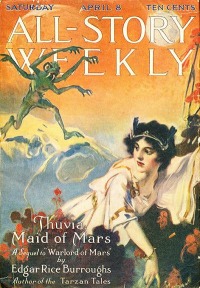
Official Edgar Rice Burroughs Tribute and Weekly Webzine Site Since 1996 ~ Over 15,000 Webpages in Archive Volume 7382  |
ERB 100-Word Drabbles
APRIL III Edition :: Days 1 - 15
See Days 16 - 30 at ERBzine 7382a
by Robert Allen Lupton
With Collations, Web Page Layout and ERBzine Illustrations and References by Bill Hillman
ROAD SIGN, I DIDN'T SEE A ROAD SIGN
April 1: On this day in 1933, Argosy Weekly published the fifth installment of “Lost on Venus.” The novel was published by Argosy in seven parts and each part had one interior illustration by Samuel Cahan.
The Paul Stahr cover illustrated the short western story, “The Hour of Fury,” by Ernest Haycox. The issue also contained part one of “Forbidden Timber,” by Frank Richardson Pierce, “The Jungle Battery” by Lieut. John Harper, “The Fourth Comrade” by J. Allan Dunn, and “The Masterman” by Max Brand.
Several illustrations and the entire text of the novel are available at: https://www.erbzine.com/mag7/0749.html
The drabble for today, “Road Sign, I Didn’t See A Road Sign,” was inspired by Carson Napier, an intrepid adventurer created by Edgar Rice Burroughs, who lost his way and landed on the wrong planet.
ROAD SIGN, I DIDN'T SEE A ROAD SIGN
![]()
Her mother exclaimed, “Another world, how preposterous! There’s nothing beyond the eternal mists above us.”
“Carson claims there are several more worlds. He comes
from a planet he calls “The Earth.”
“How did he find Amtor?”
“He sought a planet named Mars, but became lost during
his journey.”
“Did he ask directions from anyone?”
“No.”
“Evidently men on his world are like ours. They’d
let themselves starve before asking directions.”
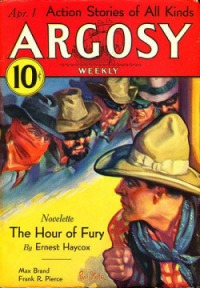
REWRITE
April 2: On this day in 1914, All-Story Weekly purchased Edgar Rice Burroughs’s novel, “The Lad and the Lion,” the first of his novels to be made into a motion picture. All-Story didn’t publish the novel for three years, when the magazine serialized the 40,000 word story in three installments beginning on June 30, 1917. The cover features a photograph from the film. Unfortunately, no known copy of the film exists.
Details about “The Lad and the Lion” may be read at: https://www.erbzine.com/mag7/0760.html
The drabble for today is “Rewrite,” and it was inspired by the several films based on the novels of Edgar Rice Burroughs, and the many directors and screenwriters who couldn’t leave his stories well enough alone.
REWRITE
![]()
“I’m not sure, but I got paid in 1914. Maybe they waited for the motion picture. I’m told that publication coordinated with the release of the film improves sales for both ventures.”
“You believe that?”
“I do. I’ll sell as many of my stories to Hollywood
as possible. People read what they watch and they watch what they read.
Familiarity gives them comfort. If they like my book, they’ll like the
movie – and vice versa. I’m confident Hollywood won’t rewrite my stories.”
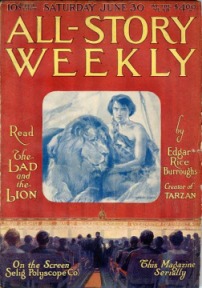
READ THE BOOK
April 3: On this day in 1934, Dame Jane Morris Goodall DBE, was born as Valerie Jane Morris - Goodall in Hampstead, London, England. Happy Birthday to her.
The world’s most preeminent primatologist and anthropologist, formally known Baroness Jane van Lawick – Goodall, is revered for her 60 year study of wild chimpanzees. She founded the Jane Goodall Institute, the “Roots and Shoots” program, and served as a board member of the “Nonhuman Rights Project. In 2002, she was named a UN Messenger of Peace. She was awarded “Dame Commander of the Most Excellent Order of the British Empire” in 2004, wrote over 20 books, and has been the subject of more than 40 films.
As a child, Jane was fascinated with the Tarzan novels, and fantasized herself living with the apes in Africa. She said that she fell in love with the Apeman and was convinced that she would have made a much better partner for him than Jane Porter. She said, “Silly man! He married the wrong Jane.”
She attended the Edgar Rice Burroughs Dum Dum event in 2012 where she received the “Golden Lion” award. Photographs of the award and other information about Dame Goodall’s Tarzan connection are available at:
https://www.ERBzine.com/mag41/4117.html
https://www.erbzine.com/mag58/goodall.jpg
READ THE BOOK
![]()
Chimpanzees, gorillas, orangutans have been living for hundreds of thousands of years in their forest, living fantastic lives, never overpopulating, never destroying the forest. They have been in a way more successful than us as far as being in harmony with the environment
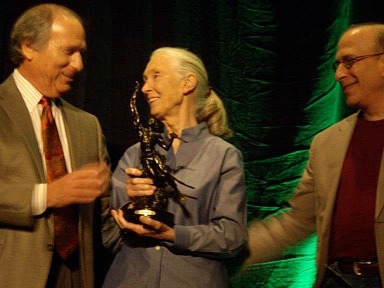
SHEEP'S CLOTHING
April 4: On this day in 1922, Actress Dorothy Hart was born in Cleveland, Ohio. She was the tenth actress to play Jane, starring opposite Lex Barker in “Tarzan’ Savage Fury.”
Hart played mostly supporting roles during her eight year career from 1947 through 1955, appearing in sixteen films and thirteen television series. Her first film was 1947’s “Gunfighters, “with Randolph Scott and her last film was “Loan Shark,” with George Raft. Eleanor Roosevelt appointed Hart to the “American Association of the United Nations’ speakers committee in 1952 and Hart retried from film, although she did begin her thirteen television appearances. She continued to model and appeared on the covers of Cosmopolitan, Esquire, and Vogue.
Details about the film, “Tarzan’s Savage Fury,” and its cast are located at:
SHEEP'S CLOTHING
![]()
“Jane, they seem real enough. Why do you think badly
of them?”
“Their eyes sparkle with greed and they argue with
each other about who carries the most diamonds. If they don’t trust each
other, we can’t trust them?”
Tarzan said, “Yes, I’ve learned that when loyalty conflicts with personal gain, loyalty almost always loses.”
“The men think their clever, but I see right through them. Loyalty to the crown may be quite continental, but diamonds are a girl’s best friend.”
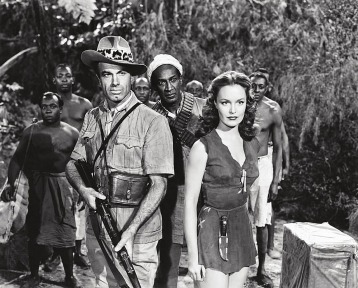
LION ON THE RUN
April 5: On this day in 1947, the film “Tarzan and The Huntress,” was released. Johnny Weissmuller played Tarzan for the eleventh time, Johnny Sheffieldmade his eighth and final appearance as “Boy,” and Brenda Joyce played Jane for her third time. She would play the role twice more. The 72 minute RKO film was directed by Kurt Neumann. The cast included Patricia Morison as the big-game huntress, John Warburton as her financial backer, and Barton MacLane as the obligatory evil leader of their safari. The working title for the film was “Tarzan’s Dangerous Game.”
Today’s drabble, “Lion on the Run,” is a quotation about filming the movie by Patricia Morison – rumors were that she and Weissmuller didn’t get along.
LION ON THE RUN
![]()
I remember the chimp going berserk, tearing around the set trying to beat up the crew. We had to hide in our cars until he calmed down. They also used an old MGM lion. It was very hot on the set, so the big stage doors were kept opened to let in air. Then suddenly, the lion disappeared. We found him walking down La Cienega Boulevard with people fleeing in all directions.”
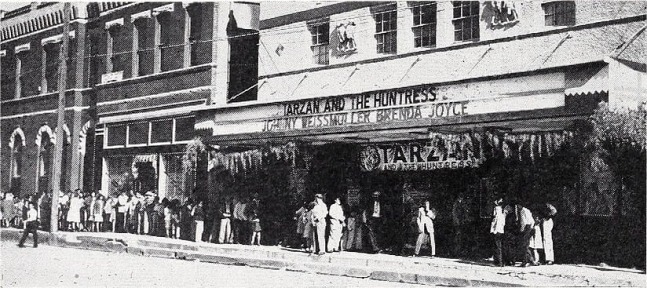
FROM WHERE I SIT
April 6: On this day in 1917, Edgar Rice Burroughs moved his family into a new home located at 700 Linden Avenue in Oak Park, Illinois. The move went unreported in the newspapers, they were busy covering the United States’ declaration of war on Germany. A very patriotic ERB wanted to join the army, but at age 42, he was a little past his prime. Instead he joined the Illinois Reserve Militia where he served as a major and helped to train recruits. Interestingly enough, during WW2 he joined the Businessmen’s Military Training Corp in Hawaii and once more, trained the volunteers.
An advertisement offering "Two houses and a vacant lot" for sale ran in an Oak Park newspaper, March 16, 1918. The 1918 advertisement said, “The home, with eight bedrooms, three baths, four toilets, a sun parlor and a glazed sleeping porch, still in splendid shape, is at 700 Linden Avenue.”
The house is not currently for sale, but on the various real estate property sites, including Zillow, it is listed as being 4800 square feet and valued between $1,250,000 and $1,400,000.
The drabble for today is “From Where I Sit,” and it was inspired by the house at 700 Linden Avenue.
FROM WHERE I SIT
![]()
“Room to grow, room for grandchildren, and room for extended family. I think it’s large enough, but we’ll buy a larger one when necessary. We deserve a big home, don’t you think?”
“What we deserve or don’t deserve depends on your perspective. As the person who cleans the bathrooms, I know that this house is larger than we need.”

REWRITE UNTIL YOU DROP
April 7: On this day in 1928, the front page of the Universal Studios paper, “Universal Weekly,” announced that Carl Laemmle had acquired motion picture rights to “Jungle Tales of Tarzan.” The twelve part serial would be produced at Universal, no doubt because Arthur Stern, vice president and general manager had an option on the book – he bought it from Burroughs in 1922. It’s always good to keep these things in the family.
Two weeks later “Universal Weekly” said that the film version of “Jungle Tales of Tarzan” would be called “Tarzan the Mighty” and that “There is a great rush amongst the mighty men of Los Angeles to play Tarzan.” Stuntman Joe Bonomo claimed to have been originally cast as Tarzan in “Tarzan the Mighty,” but the first week of filming, a vine broke during a stunt and Bonomo broke his leg and injured his hip. He suffered a long hospital stay and recurrent hip problems. The injuries ended his career. Check out his autobiography, “The Stuntman.”
For details, go to https://www.erbzine.com/mag63/6391.html for an article based on Scott Tracy Griffin’s book, “Tarzan on Film.”
The drabble for today is “Rewrite Until You Drop,” and it was inspired by the lack of similarity between “Jungle Tales of Tarzan” and “Tarzan the Mighty,” the serial allegedly based on the book.
REWRITE UNTIL YOU DROP
![]()
“Well, first we changed the name to “Tarzan the Mighty.”
“I see. As I recall Tarzan’s either a child or a young man in about a dozen stories.”
“Arthur, we aren’t using any of those stories. The screenplay is about Tarzan and a castaway, Mary Trevor.”
“Wait. We aren’t using the book title or its storyline and there’s no Jane. I assume that Tarzan will still be called Tarzan?”
“Of course.”
“That’s good. I was afraid I wasted my money when
I paid that Burroughs guy.”
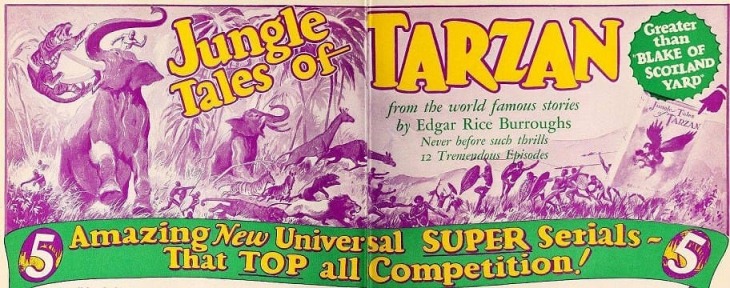
CAT WHISPERER
April 8: On this day in 1916, All-Story Weekly published part one of the fourth Barsoom novel, “Thuvia, Maid of Mars.” The story features Carthoris, the son of John Carter and Dejah Thoris, and of course the title character, Thuvia. P. J. Monahan did the cover illustration, which was also used for the McClurg first edition of the book. There were no interior illustrations.
The issue contained the 2nd installment of a serialized version of “The Brass Check’ by George Allan England, and “The Perishin’ Gun-Sights” by Captain A. E. Dingle, who spent 22 years at sea and was shipwrecked five times. I think I might have stayed home after the third shipwreck, but I’m a slow learner. Robert Ames Bennet contributed “Finders Keepers’, and the prolific Achmed Abdullah (Alexander Nicholayevitch Romanoff) wins my prize for the best title of the issue, “The God of the Invincibly Strong Arms.”
The drabble for today, “Cat Whisperer,” was inspired by “Thuvia, Maid of Mars” written by Edgar Rice Burroughs.
CAT WHISPERER
![]()
The maiden, Thuvia, said. “Stand down, warrior. He means no harm. A painful bone is lodged between his teeth.”
“How do you know?”
“As you mentally command thoats, your mounts, I communicate
with banths.
The feline held its mouth open and Thuvia removed
a sharp bone lodged in its gums. She ordered it to roll over and rubbed
its stomach.
Carthoris asked, “Do banths always obey you?”
“I’m very purr-suasive.”
COMMUNITY STANDARDS
April 9: On this day in 1934 “Tarzan and His Mate,” starring Johnny Weissmuller and Maureen O’Sullivan debuted in Los Angeles, California. The film opened in New York City eleven days later on April 20th.
In 2003 The United States Library of Congress deemed The Metro-Goldwyn Mayer picture to be “culturally, historically or aesthetically significant and selected it for preservation in the National Film Registry.
Jane’s costume, a halter top and loincloth, left her thighs and hips exposed. Additionally, she sleeps sans clothing and swims naked. Censors complained that another shocking issue was that Jane and Tarzan slept together without being married. However, an earlier scene in the film challenged this observation – Tarzan brings Jane breakfast and says, “Love my wife.”
Actress Josephine McKim, an Olympic gold medal winner, like Weissmuller, doubled for O’Sullivan in the nude underwater ballet with Tarzan. The result of that scene, combined with O’Sullivan’s risqué costume, was that Will Hays of the Motion Picture Production Code Office rejected the film. The film was reedited to meet the standards of differing markets and at least three different versions exist. Hays observed that the woman appeared “Stark Naked.”
Visit https://www.erbzine.com/mag6/0615.html for more details about the film.
The drabble for today is “Community Standards.”
COMMUNITY STANDARDS
![]()
Hyman said, “Never? How sad for you.”
“Don’t be flippant. Besides, Tarzan and Jane sleep
together and they aren’t married.”
“No, Tarzan says “Love my wife” early in the film
and the underwater scenes are tasteful and artistic, almost a ballet.”
“Calling it a ballet doesn’t mean it isn’t smut. Dirty,
dirty, dirty.”
“I’m sorry. Would it help if we found a scarlet letter
to put on Jane’s costume?”

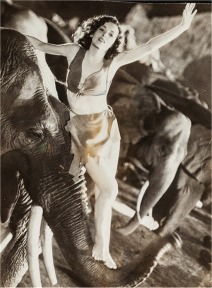
ALOHA
April 10: On this day in 1935, the S. S. Lurline arrived in Honolulu with Edgar Rice Burroughs and his bride, the former Florence Gilbert aboard. The Honolulu Star-Bulletin, a paper Burroughs would later write for during World War Two, covered the event and published an article the the next day, April 11, 1935. The article was titled “Edgar Rice Burroughs is Greeted With a Hawaiian Type of Own Character.” The couple stayed at the Royal Hawaiian Hotel until April 27, 2021.
The entire article may be read athttps://www.erbzine.com/mag11/1127.html#2
The drabble for today is “Aloha,’ and it’s an excerpt from that newspaper article.
ALOHA
![]()
Today, the Tarzan who greeted Burroughs is a native Hawaiian who swims like a fish. He climbed the Lurline, hung from a rail, and greeted his literary father.
The "father" is Edgar Rice Burroughs, creator of the famous character, who arrived aboard the Lurline today on a honeymoon trip with Mrs. Burroughs, the former Florence Gilbert of the screen.
Mr. Burroughs received Tarzan's lei with appreciation.
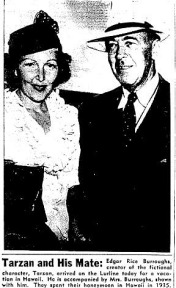
NOTHING UP MY SLEEVE
April 11: On this day in 1929, the April issue of “Modern Mechanics and Inventions” hit the stands. The magazine contained the third and final installment of “Lost Inside the Earth,” a retitled reissue of “At the Earth’s Core,” by Edgar Rice Burroughs. The first installment of “Carter of the Red Planet,” actually “A Princess of Mars,” retitled also appeared in the issue.
The cover, by an unknown artist, had nothing to do with either Edgar Rice Burroughs story contained therein.
This pulp-size magazine, published by Fawcett Publications in Chicago,, Illinois. During the period from November 1928 to July 1929 it serialized reprints of three Edgar Rice Burroughs novels: The Moon Maid as “Conquest of the Moon” (Nov 28 to Feb 1929), At the Earth’s Core as “Lost Inside the Earth” (Feb to Apr 1929), and Under the Moons of Mars as “Carter of the Red Planet” (Apr to Jul 1929). MM&I published no original fiction.
The drabble for today is “Nothing Up My Sleeve?” and was inspired by the retitled releases of the three Edgar Rice Burroughs’s novels published by Modern Mechanics and Inventions.
NOTHING UP MY SLEEVE
![]()
The Modern Mechanics editor said, “Will Rogers said
that you can fool some of the people all of the time.”
“Your issues don’t contain any modern mechanics, just
reprints of old stories.”
“And all of the people some of the time.”
“I suspect that your strategy won’t work for long.
Remember the rest of the Will Rogers quotation. You can’t fool all of the
people all of the time.”
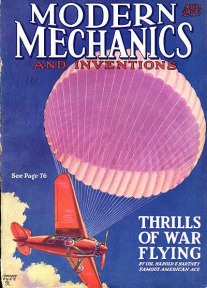
POACHER'S TRAP
April 12: On this day in 1992, the 20th episode of the syndicated television series, “Tarzan,” titled “Tarzan’s Eleventh Hour” was broadcast. This episode, and all the rest, are available for viewing on Peacock.
There were a total of 75 episodes in this series which starred Wolf Larson as Tarzan and Lydie Denier as Jane. Sean Roberge played a young man Roger Taft Jr. in every episode. Roberge was killed in a car accident at the age of 23, barely a year after appearing in the last episode of Tarzan.
Tarzan must step in to prevent a tragedy when Cheetah runs away from home, leaving Tantor the elephant heartbroken, and leading Roger to risk his life to reunite the two jungle friends. Cheetah falls into a poacher’s pit and is left there by the poacher to entice Tantor to his death.
The drabble for today is “Poacher’s Trap,” and it is inspired by the works of Edgar Rice Burroughs, the television episode, “Tarzan’s Eleventh Hour,” and the plight of elephants around the world.
POACHER'S TRAP
![]()
Roger Taft, a young friend of Tarzan, said, “I’ll find
Cheetah. It hurts me to see Tantor so unhappy.”
Tarzan replied, “No, stay here. Tantor will be highly
agitated with both of you missing and he will go searching for you. The
jungle is full of elephant poachers. One may capture Cheetah and use him
to lure Tantor into a trap.”
“I don’t understand why men kill elephants.”
Tarzan replied, “Nor do I, no one needs an elephant
tusk except an elephant.”
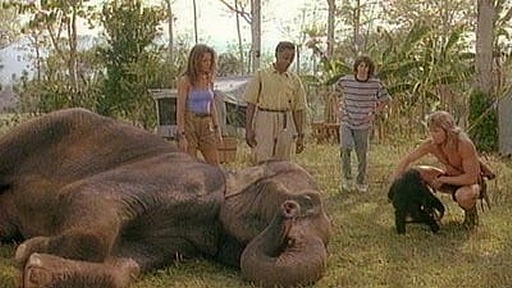
ENEMY OF MY ENEMY
April 13: On this day in 2011, Dark Horse Comics released “The Outlaw Prince,” a retitled and beautiful illustrated version of Edgar Rice Burroughs’s novel, “The Outlaw of Torn.” The story was adapted for the graphic version by Rob Hughes. The pencils were by Thomas Yeates and Michael Kaluta, inks by Yeates, and coloring by Yeates and Lori Almeida. Lettering was done by Steve Dutro and the cover artist was Esad Ribic. The deluxe edition included an afterword by Frank Westwood, an article, “In Search of the Outlaw,” by Rod Jackson, and a cover by Alan Lathwell.
More details and illustrations from the edition are at: https://www.erbzine.com/mag36/3601.html
The book is available from Amazon: https://www.amazon.com/Outlaw.../dp/1595827102/ref=sr_1_1...
Today’s drabble, “Enemy of my Enemy,” is from the blurb for the graphic edition of the book.
ENEMY OF MY ENEMY
He's trained to become the greatest swordsman the world has ever known-- and grows to be the most dreaded name in all of Britain, but the fate of England may very well rest in his hands!
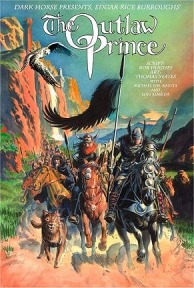
YOU GOTTA READ THIS STUFF
April 14: On this day in 1965, Richard A. Lupoff’s “Edgar Rice Burroughs: Master of Adventure” was published in hardcover by Canaveral Press. The book, with a plain green DJ included a preface by Henry Hardy Heins and illustrations by Frazetta, Al Williamson, and Reed Crandall. This was the first ‘biography ‘of ERB that I’d ever seen. I was barely in high school, and as far as I knew, I was the only person who read Burroughs. I had no idea about fandom, the Burroughs Bibliophiles, or even pulp magazines.
The book was reprinted in 1968. A third edition, “the centennial edition, added a new introduction and a new Frazetta cover. This hardcover edition was reprinted by Ace Books in 1975. Bison Books revised and republished the book as a trade paperback in 2005, retitling it “Master of Adventure: The Worlds of Edgar Rice Burroughs. A new foreword by Michael Moorcock was added.
Jon Barnes wrote a review of the Richard A. Lupoff book when it was republished by Bison Books in 2005. The entire review is available at https://www.erbzine.com/mag30/3048.html
A portion of that review is included here as “You Gotta Read This Stuff,” the drabble for today.
YOU GOTTA READ THIS STUFF
![]()
Despite cranking out books at an improbable rate, Burroughs was capable of political satire, lampooning Hitler and Mussolini, impressively detailed world-building, as well as formal inventiveness, and inserting a self-deprecating version of himself into his own stories. Richard A. Lupoff's cheerful critical overview of Burroughs's long career, first published in 1965, is reissued in updated form, with an extra chapter and the occasional, baffled-sounding footnote about "the internet".
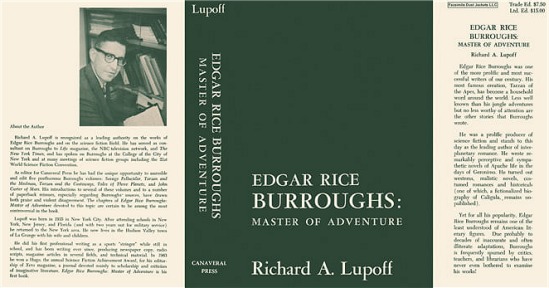
KING KING
April 15: On this day in 1932, Edgar Rice Burroughs Incorporated published the first edition of “Jungle Girl,” with a cover and six interior plates by Studley O. Burroughs. The first edition had a print run of 5,333 copies. The working title for this book that takes place in what is now Cambodia was “The Dancing Girl of the Leper King” and was originally serialized in Blue Book Magazine as “The Land of Hidden Men.” Ace Books published paperback versions of the novel in 1963 and 1969 using the Blue Book title, “The Land of Hidden Men.”
The story bears no resemblance to the Frances Gifford film serial of the same name. For publication details and other information about the story, visit https://www.erbzine.com/mag7/0776.html.
The drabble for today is “King King,” and it was inspired by the “Jungle Girl” by Edgar Rice Burroughs.
KING KING
![]()
“Will you call yourself King Gordon or King King?”
“Well, Gordon means a large fortification, so King
Gordon sounds like a man who protects his people, but King King makes better
song lyrics – like ‘King King was a mighty king.’
Lodivarman scowled. “If I die with that lyric in my
head, I will haunt you forever.”
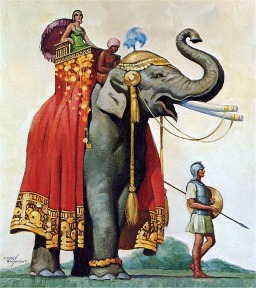
P![]()
![]()
See
Days 16-30 at ERBzine 7382a
![]()
APRIL IIIa ILLUSTRATIONS COLLAGE
![]()
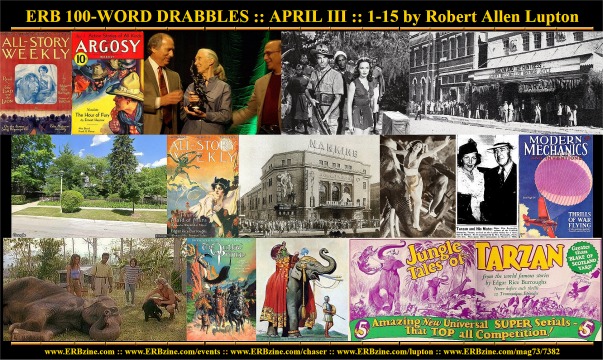
Click for full-size promo collage
